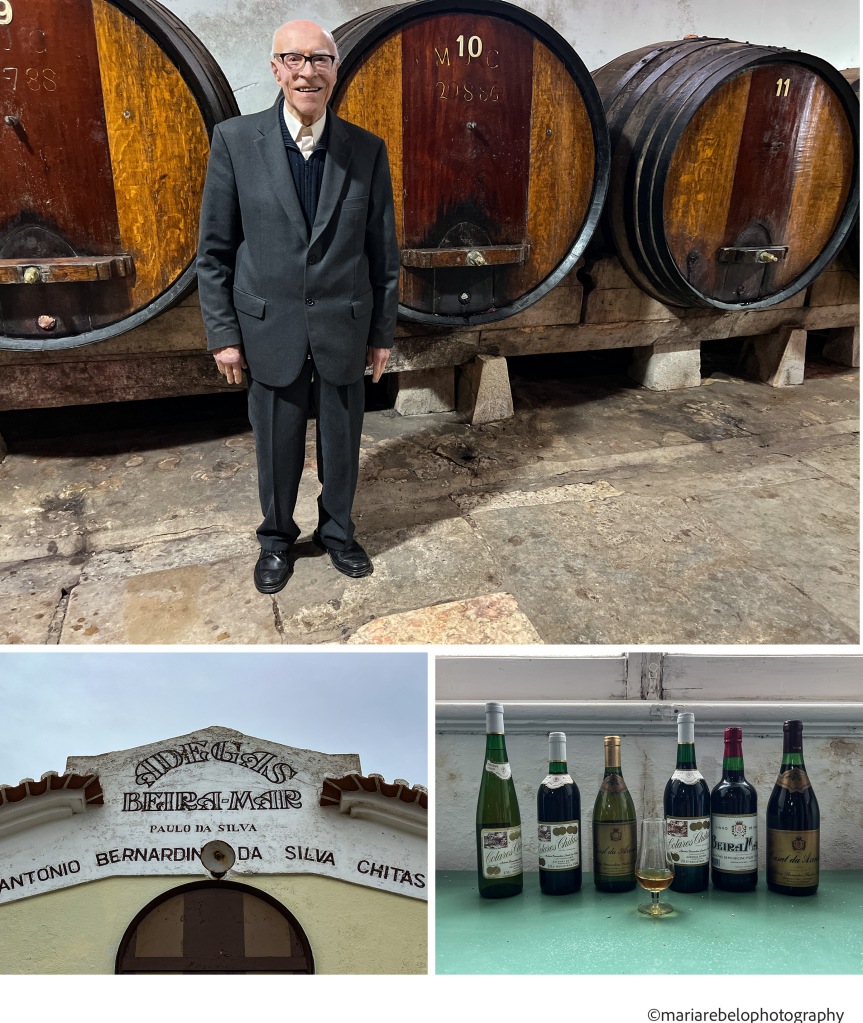
The rain fell hard, trying to make up for the dry spring and summer. But we were not deterred. We drove through the narrow road that leads to Colares to meet a legendary winemaker: the 97-year-old Paulo da Silva, affectionately known as Chitas (pronounced cheetahs), the nickname he inherited from his grandfather.
We stopped at Adega Beira Mar, which means cellar by the sea, an apt description. Paulo came out to greet us, his slender figure dressed in a dark suit. It was chilly inside the building, but he did not seem to mind. “Is it the cold or the wine that is the secret of your longevity?” we asked. Paulo replied with a smile. “My father liked to say that drinking a bottle of our wine with lunch and another with dinner would extend your life. But I prefer a small glass of wine with my meals.”
Paulo has an amazing memory for dates, facts, and figures. He tells us the building was erected in 1898 by his grandfather. “This place has seen it all: the two world wars, the Great Depression.”
In Colares, the vine planting process is unique. Farmers dig holes in the sand until they find a clay bed where they can plant the vine roots. The sandy soil served as a natural barrier against phylloxera, an insect that devastated many European vineyards in the latter half of the 19th century.
With wine production declining in other regions, Colares thrived. Many producers prospered by exporting their wine to Brazil. Paulo’s grandfather, António, was a foreman for one of these exporters, Manuel José Colares. António’s work ethic and dedication were so great that Manuel bequeathed him part of his business. But when the Great Depression came, Brazil did not pay for the wine, and most companies went bankrupt. The few that survived have since been sold or closed. Only Paulo’s Adega Beira Mar remains in the same family. “The wines have earned 71 prizes since 1889, two just last year,” he tells us.
Over the past few decades, the construction of summer residences in Colares has gradually encroached upon the land occupied by vineyards, reducing it to 30 hectares. Paulo da Silva owns some vines, but for most of his life, he was what the French call a “negociant,” a savvy wine merchant. His expertise lies in identifying superior wines, aging them to perfection, and then selling them. “Time is the secret of Colares wine,” he explained. The region’s two signature varietals, the white Malvasia and the red Ramisco, need time to develop complexity and finesse.
On one occasion, the former President of Portugal, Jorge Sampaio came to visit Paulo. The president asked, “What is the oldest wine in the cellar?” “It is from 1955,” responded Paulo. “You kept that wine for too long,” said the president. “It has surely gone bad.” Paulo fetched a bottle from 1955 and offered it to the president. A few weeks later, the president called in the evening to say, “We tried that wine at dinner tonight, and it was exceptional. I learned something new— Colares wines have a remarkable longevity.”
We sampled a Malvasia from 1996 that was lively and crisp, with aromas of citrus and green olives and a hint of saltiness on the palate. A marvel!
Paulo led us to see some Ramisco vines he had planted in the sandy soil near the cellar just two years ago. “Look how well they’re doing,” he said with pride. He then gestured towards an unoccupied section of the yard. “Over there, I’m planning to build a new cellar to boost our production,” he explained.
Perhaps Colares wines are the secret to eternal youth and vigor. We purchased a few bottles to test this theory. It promises to be an enjoyable experiment.

Amazing guy! Sounds like a winning formula.
Absolutely!
I need to go try these wines!
Absolutely!
What a lovely story. I found your blog via the equally lovely RestlessJo.
Welcome and thank you for reading our blog.